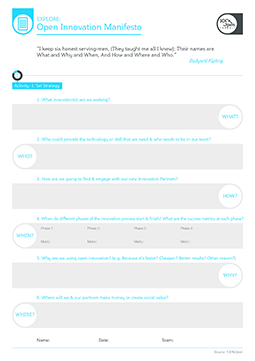Open Innovation Manifesto
“I KEEP six honest serving-men(They taught me all I knew);
Their names are What and Why and When
And How and Where and Who.”
Rudyard Kipling


The Open Innovation Manifesto gives us the strategic rationale and development plan for our innovation programme. It makes the case for open innovation and helps plan and communicate the programme effectively. It’s a manifesto because it is a statement of belief and intent.

It is best to involve a wide selection of colleagues in building our open innovation strategy. We could conduct interviews with senior stakeholders using the questions in the Open Innovation Manifesto as a structure, or start filling in the Open Innovation Manifesto straight away by answering the 6W questions in a workshop. Whichever process we choose, we note which of the questions cause most debate or any gaps we can’t address, and return to those later.
What innovation are we seeking? Describe the objectives of our open innovation programme here. What type of innovation (e.g. product, service, technology, process, business model) are we seeking? What level of market readiness do we need? The ‘What’ needs to tie in with our company innovation strategy (see Vectors for more detail).
Who could provide the technology, service or skill that we need? Outline the likely external sources of innovation (e.g. existing suppliers, entrepreneurs, universities, SMEs). See Network Builder for more detail.
Who needs to be in our team? Internal stakeholders will need to work together for a successful open innovation project. We aim to involve R&D, Production, Legal, HR, Risk, Strategy, Marketing and Distribution. One good idea is to invite the most influential of these people onto a panel to judge the best innovations so they have a genuine stake in the outcome. For involving a wider group of colleagues we could use the Colleague Crowd tool.
How are we going to find and communicate with potential Innovation Partners? Will we hire an innovation intermediary or use a trade association? Or use social media, compile email lists or publish a dedicated web site?
When do different phases of the innovation process start and finish? What are the success metrics at each phase? First step is to determine the launch date of our innovation and work back. If it is needed in a year’s time how long are we going to need for coming up with ideas? When are we going to commit to the best idea? How long will it take to prototype? Is there time to build and test our idea in time to launch and scale it?
We should commit to metrics at this stage. How many ideas are we looking for? How many do we want to prototype? Is there a minimum business opportunity size e.g. £10m+ revenue a year?
Why are we using open innovation? Because it’s faster? Cheaper? Better results? Other reason? Are we using open innovation to find more radical ideas or technologies that we need now but cannot create ourselves within the available time or budget?
Where will we and our partners make money or create social value? Here we think about the top level business case for open innovation. How will open innovation create value for our partners and us? What kind of value will this be? (See Give|Get and Open Innovation Models for more information)
You must be logged in to download this tool
You must be logged in to download this worked example
2014 - 100%OPEN LTD